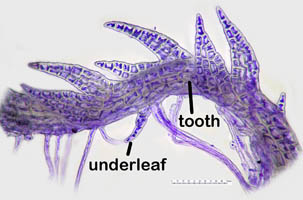Guide to Liverworts of Oregon: Key to Cephaloziella 1
HOME SPECIES INDEX GENUS INDEX GLOSSARY
1b plants leafy > 3b leaves not divided, not ciliate > 6a oil bodies 2+ or unknown > 7b no small dorsal lobe > 10a succubous > 11a anisophyllous > 12b leaves lobed > 37b if rhizoids red, stems red > 38b shoots mostly <0.5 mm wide > 47b underleaves inconspicuous > 50b leaves spreading or remote > 52a leaves transverse > 53b lobes < 10 cells wide > Cephaloziella
The genus Cephaloziella is notoriously difficult. The difficulty is attributable to the small size of all members of the genus and the subtlety of characters that separate the species. Only a few species are distinctive enough to be recognizeable without analyzing the sexuality of a plant. Thus, it is very important to look for perianths when collecting in the field and to do careful dissections before beginning to key the species. The best character to differentiate between several species is whether or not a species is paroicous. Determining whether or not a species is dioicous or autoicous is especially difficult. If organic connection between an androecium and a perianth can be clearly established then the autoicous nature of a plant is certain. However, if no connection can be demonstrated it does not necessarily mean that a species is dioicous, especially if both male and female structures are observed in the same patch.
The most common species is C. divaricata, a dioicous species characterized by triangular leaf lobes and the consistent presence of small but regularly produced underleaves. Cephaloziella divaricata occurs in a wide variety of habitats, on both organic and inorganic substrates. It is common on burnt wood, soil, and rock. It is wise to learn this species well so it can be ruled out before deciding another species is at hand.
 Cephaloziella divaricata. Nevada County, California. Beyer 7051.
Cephaloziella divaricata. Nevada County, California. Beyer 7051.
1a Leaves divided only 0.5--0.7 their length; leaf margins of sterile shoots entire, sometimes sparsely spinose-dentate or with occasional basal teeth.
(COUPLET 2)

 Left: Cephaloziella turneri. Douglas County, Oregon. DHW 7171. Right: Cephaloziella spinigera.Alaska. Potemkin 935002.(ALA)
Left: Cephaloziella turneri. Douglas County, Oregon. DHW 7171. Right: Cephaloziella spinigera.Alaska. Potemkin 935002.(ALA)
1b Leaves deeply bifid, divided 0.7--0.8 their length; leaf margins of sterile shoots regularly dentate, serrate or spinose throughout, sometimes with only basal teeth.
(COUPLET 6)